
INTRODUCTION TO MOROCCO
For Westerners, Morocco holds an immediate and enduring fascination. Though just an hour’s ride on the ferry from Spain, it seems at once very far from Europe, with a culture – Islamic and deeply traditional – that is almost wholly unfamiliar. Throughout the country, despite the years of French and Spanish colonial rule and the presence of modern and cosmopolitan cities like Rabat and Casablanca, a more distant past constantly makes its presence felt. Fez, perhaps the most beautiful of all Arab cities, maintains a life still rooted in medieval times, when a Moroccan kingdom stretched from Senegal to northern Spain, while in the mountains of the Atlas and the Rif, it’s still possible to draw up tribal maps of the Berber population. As a backdrop to all this, the country’s physical make-up is extraordinary: from the Mediterranean coast, through four mountain ranges, to the empty sand and scrub of the Sahara.
Across much of the country, the legacy of colonial occupation is still felt in many aspects of daily life. The Spanish zone contained Tetouan and the Rif, the Mediterranean and the northern Atlantic coasts, Sidi Ifni and the Tarfaya Strip; the French zone the plains and the main cities (Fez, Marrakesh, Casablanca and Rabat), as well as the Atlas. And while Ceuta and Melilla are still the territory of Spain, it is the French – who ruled their “protectorate” more closely – who had the most lasting effect on Moroccan culture, Europeanizing the cities to a strong degree and firmly imposing their language, which is spoken today by all educated Moroccans (after Moroccan Arabic or one of the three local Berber languages).
This blend of the exotic and the familiar, the diversity of landscapes, the contrasts between Ville Nouvelle and ancient Medina, all add up to make Morocco an intense and rewarding experience, and a country that is ideally suited to independent travel – with enough time, you can cover a whole range of activities, from hiking in the Atlas and relaxing at laidback Atlantic resorts like Asilah or Essaouira to getting lost in the back alleys of Fez and Marrakesh. It can be hard at times to come to terms with the privilege of your position as a tourist in a country with severe poverty, and there is, too, occasional hassle from unofficial guides, but Morocco is essentially a safe and politically stable place to visit: the death in 1999 of King Hassan II, the Arab world’s longest-serving leader, was followed by an easy transition to his son, Mohammed VI, and the country pretty much carried on as normal while the Arab Spring uprisings toppled governments in nearby Libya, Tunisia and Egypt. Indeed, your enduring impressions are likely to be overwhelmingly positive, shaped by encounters with Morocco’s powerful tradition of hospitality, generosity and openness. This is a country people return to again and again.
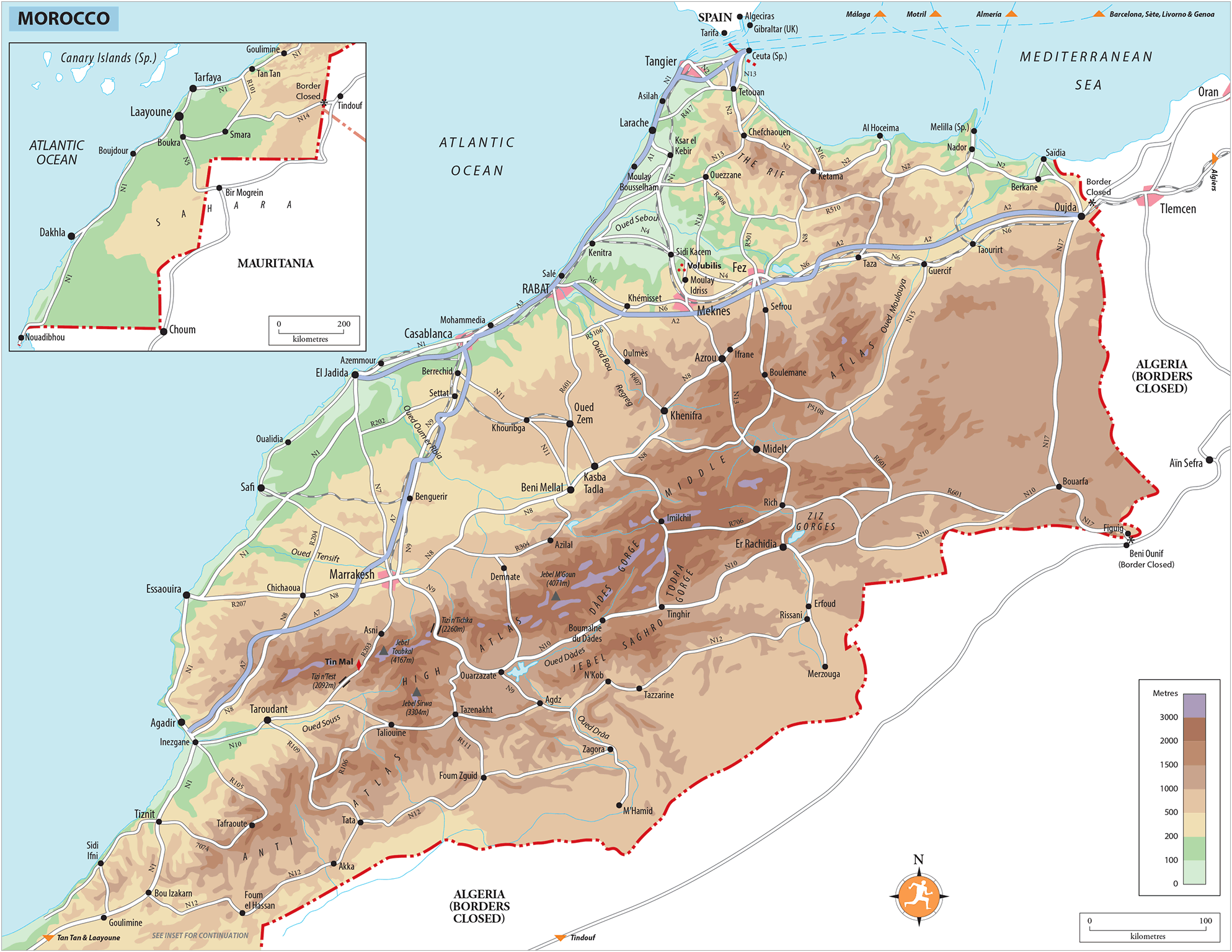

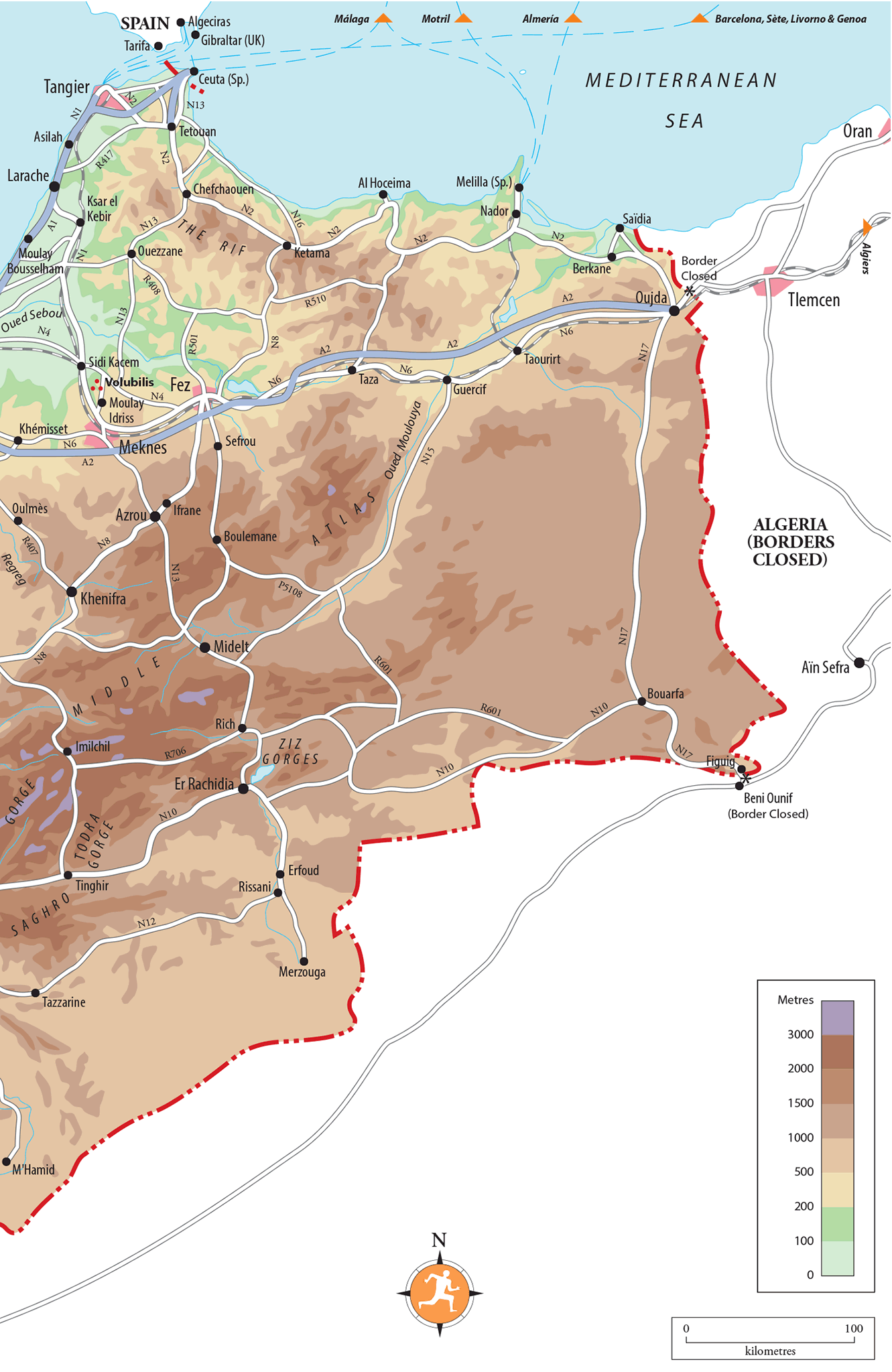
FACT FILE
- Morocco’s area of 446,550 square kilometres (722,550 sq km including the Western Sahara) makes it slightly smaller than France or Spain, slightly larger than California. The population of just over 33 million compares with just eight million at independence in 1956.
- Nearly 99 percent of Moroccans are Muslim, with 1 percent Christian and a tiny minority (an estimated 6000 people) Jewish. The literacy rate is 68.5 percent (78.6 percent for men, 58.8 percent for women).
- The main languages are Arabic, Berber (Tarfit, Tamazight and Tashelhaït) and French. Spanish is still widely spoken in the north, and English is increasingly spoken by young people, especially in tourist areas.
- Morocco gained independence from French and Spanish rule on March 2, 1956. The head of state is King Mohammed VI, who succeeded his father Hassan II on July 30, 1999. The government is chosen from an elected legislature and is currently run by Prime Minister Abdelilah Benkirane of the moderate Islamist PJD (Party of Justice and Development). The main opposition parties are the Istiqlal (Independence) Party, Morocco’s oldest political group, and the RNI (National Rally of Independents).
- Such is the importance of date palms in the Moroccan south that oases are traditionally measured by the number of their palms rather than their population, and it was once illegal to sell a date tree, a historically vital source of food.
- Despite the beauty of zellij work in medersas and fountains across the country, it is thought that there is at least one flaw in every mosaic due to the Islamic belief that only Allah can create perfection.
Where to go
Geographically, the country divides into four basic zones: the coast (Mediterranean and Atlantic); the great cities of the plains; the Rif and Atlas mountains; and the oases and desert of the pre- and fully fledged Sahara. With two or three weeks – even two or three months – you can’t expect to cover all of this, though it’s easy enough (and highly recommended) to take in something of each aspect.
Broadly speaking, the coast is best enjoyed in the north at Tangier – still shaped by its old “international” port status despite undergoing considerable recent renovation – Asilah and Larache, and in the south at El Jadida, Essaouira, perhaps the most easy-going resort, or remote Sidi Ifni. Agadir, the main package-tour resort, is less worthwhile – but a functional enough base for exploration.
Inland, where the real interest of Morocco lies, the outstanding cities are Fez and Marrakesh. The great imperial capitals of the country’s various dynasties, they are almost unique in the Arab world for the chance they offer to witness city life that, in patterns and appearance, remains in large part medieval. For monuments, Fez is the highlight, though Marrakesh is for most visitors the more enjoyable.
Travel in the south is, on the whole, easier and more relaxing than in the sometimes frenetic north. This is certainly true of the mountain ranges, where the Rif can feel disturbingly anarchic, while the southerly Atlas ranges (Middle, High and Anti-) that cut right across the interior are beautiful and accessible. Hiking in the High Atlas, especially around North Africa’s highest mountain, Jebel Toubkal, is increasingly popular, following old mule paths through mud-brick villages or tackling some of the impressive peaks. Summer treks are possible at all levels of experience and altitude, and despite inroads made by commercialization, the area remains essentially “undiscovered” – like the Alps must have been in the nineteenth century.
Equally exploratory in mood are the great southern routes beyond the Atlas, amid the oases of the pre-Sahara. Major routes here can be travelled by bus, minor ones by rented car or local taxi, the really remote ones by 4WD vehicles or by getting lifts on local camions (lorries), sharing space with market produce and livestock. The oases, around Tinghir, Zagora and Erfoud, or (for the committed) Tata, are classic images of the Arab world, vast palmeries stretching into desert horizons. Equally memorable is the architecture that they share with the Atlas – bizarre and fabulous pisé (mud) kasbahs and ksour, with Gothic-looking turrets and multi-patterned walls.
Further south, you can follow a route through the Western Sahara all the way down to Dakhla, just 22km short of the Tropic of Cancer, where the weather is scorching even in midwinter.
ARABS AND BERBERS
The Amazigh – more commonly known as Berbers – were Morocco’s original inhabitants. The Arabs arrived at the end of the seventh century, after sweeping across North Africa and the Middle East in the name of their revolutionary ideology, Islam. Eventually, nearly all the Berbers converted to the new religion and were immediately accepted as fellow Muslims by the Arabs. When Muslim armies invaded the Iberian peninsula from Morocco, the bulk of the troops were Berbers, and the two ethnic groups pretty much assimilated. Today, most Moroccans can claim both Arab and Berber ancestors, though a few (especially Shereefs, who trace their ancestry back to the Prophet Mohammed, and have the title “Moulay”) claim to be “pure” Arabs. In the Rif and Atlas mountains, and in the Souss Valley, though, groups of pure Berbers remain, and retain their ancient languages (Tarfit, spoken by about 1.5m people in the Rif; Tamazight, spoken by over 3m people in the Atlas; and Tashelhaït, spoken by around 4m people in the Souss Valley region). Recently, there has been a resurgence in Berber pride (often symbolized by the Berber letter Ж); TV programmes are now broadcast in Berber languages, and they are even taught in schools, but the country’s majority language remains Arabic.
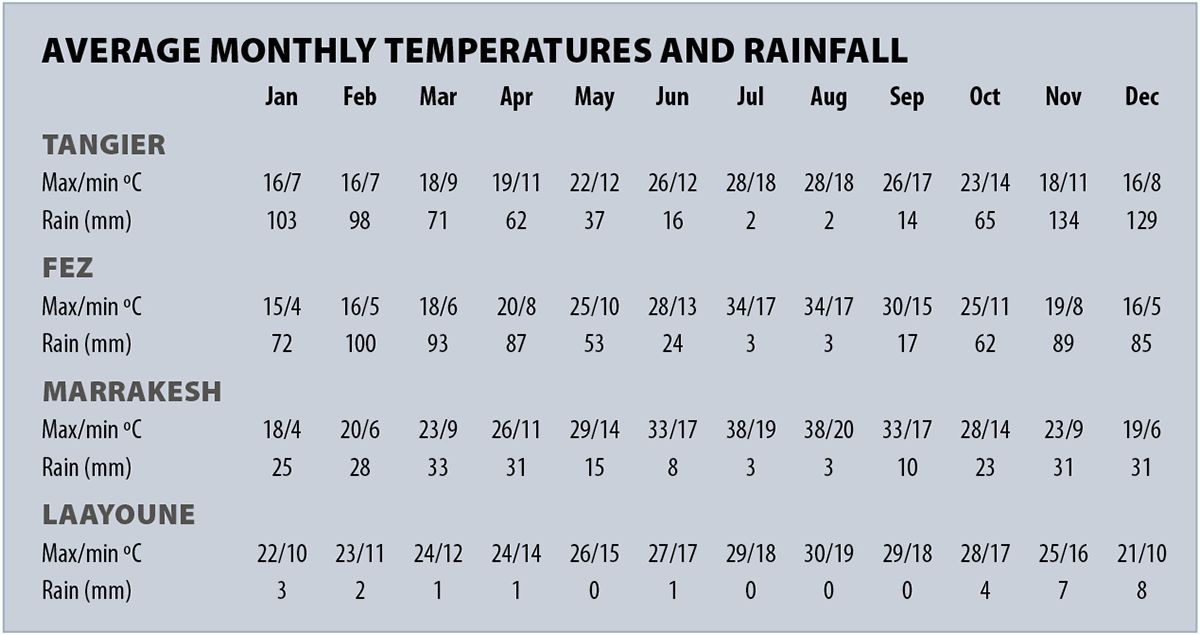

CLOCKWISE FROM TOP SOUK, MARRAKESH; DATES, NUTS AND PASTRIES; SIDI AHMED TIJANI MOSQUE, FEZ
When to go
As far as the climate goes, it is better to visit the south – or at least the desert routes – outside midsummer, when for most of the day it’s far too hot for casual exploration, especially if you’re dependent on public transport. However, temperatures in July and August – the hottest months – reach an ideal level on the coast, although resorts often get overrun with Moroccan tourists flocking here to escape the inland heat.
Spring, which comes late by European standards (around April and May), is perhaps the best overall time, with a summer climate in the south and in the mountains, as well as on the Mediterranean and Atlantic coasts. Relatively moderate conditions also permeate the country in early autumn (September and October), another optimal time to travel. Winter can be perfect by day in the south, though desert nights can get very cold – a major consideration if you’re staying in the cheaper hotels, which rarely have heating. If you’re planning to hike in the mountains, it’s best to keep to the months from April to October unless you have some experience of snow conditions.
Weather apart, the Islamic religious calendar and its related festivals will have the most seasonal effect on your travel. The most important factor is Ramadan, the month of daytime fasting; this can be a problem for transport, and especially hiking, though the festive evenings do much to compensate.

FROM LEFT SURFERS AT TAGHAZOUT; CASABLANCA TRAM; ART DECO ARCHITECTURE, SIDI IFNI
AUTHOR PICKS
Our authors have haggled in the souks and camped in the desert, clocked up the kilometres aboard buses and on mules, and generally consumed more mint tea than can possibly be good for them. Here are a few of their favourite things…
Helping Hands in the Happy Valley Shop at truly fair-trade associations in the Aït Bouguemez valley by visiting Anou-certified cooperatives, where artisans in remote regions sell their work directly to customers.
Take the tram Modern tramway networks have been constructed in Rabat and Casablanca, offering an easier way to get to the sights while rubbing shoulders with the locals.
Rfissa After a trek in the High Atlas, unwind at Dar Warawte and tuck into this traditional feast dish. A base of torn meloui (day-old tortilla-like bread) is topped with spiced lentils, fenugreek seeds and a large portion of meat.
Stargaze in the Sahara Head to North Africa’s first private observatory, Kasbah Hotel SaharaSky, for an unforgettable evening of rooftop stargazing and venture onwards into the Chigaga dunes to camp in one-million-star accommodation.
Surfing in Taghazout A line-up of good right-hand breaks have made this friendly, easy-going little fishing village into Morocco’s top surf spot.
The painted rocks of Tafraout Out in the middle of nowhere, tiny Tafraout is surrounded by some of Morocco’s most jaw-dropping scenery including an incongruous collection of blue-painted boulders which make it seem as though the sky has somehow leaked into the ground.
Sidi Ifni’s quirky Art Deco buildings The period oddities in this charming former Spanish enclave, built from scratch in the 1930s, include a ship-shaped naval secretariat, an Art Deco mosque, an Art Deco lighthouse and a post office that used to issue its own stamps.
Our author recommendations don’t end
here. We’ve flagged up our favourite places – a perfectly sited hotel, an
atmospheric café, a special restaurant – throughout the Guide, highlighted with the
 symbol.
symbol.
27 THINGS NOT TO MISS
It’s not possible to see everything that Morocco has to offer in one trip – and we don’t suggest you try. What follows is a selective and subjective taste of the country’s highlights, in no particular order: fascinating cities, Roman ruins, mountain hikes and stunning buildings. All entries have a reference to take you straight into the Guide, where you can find out more.
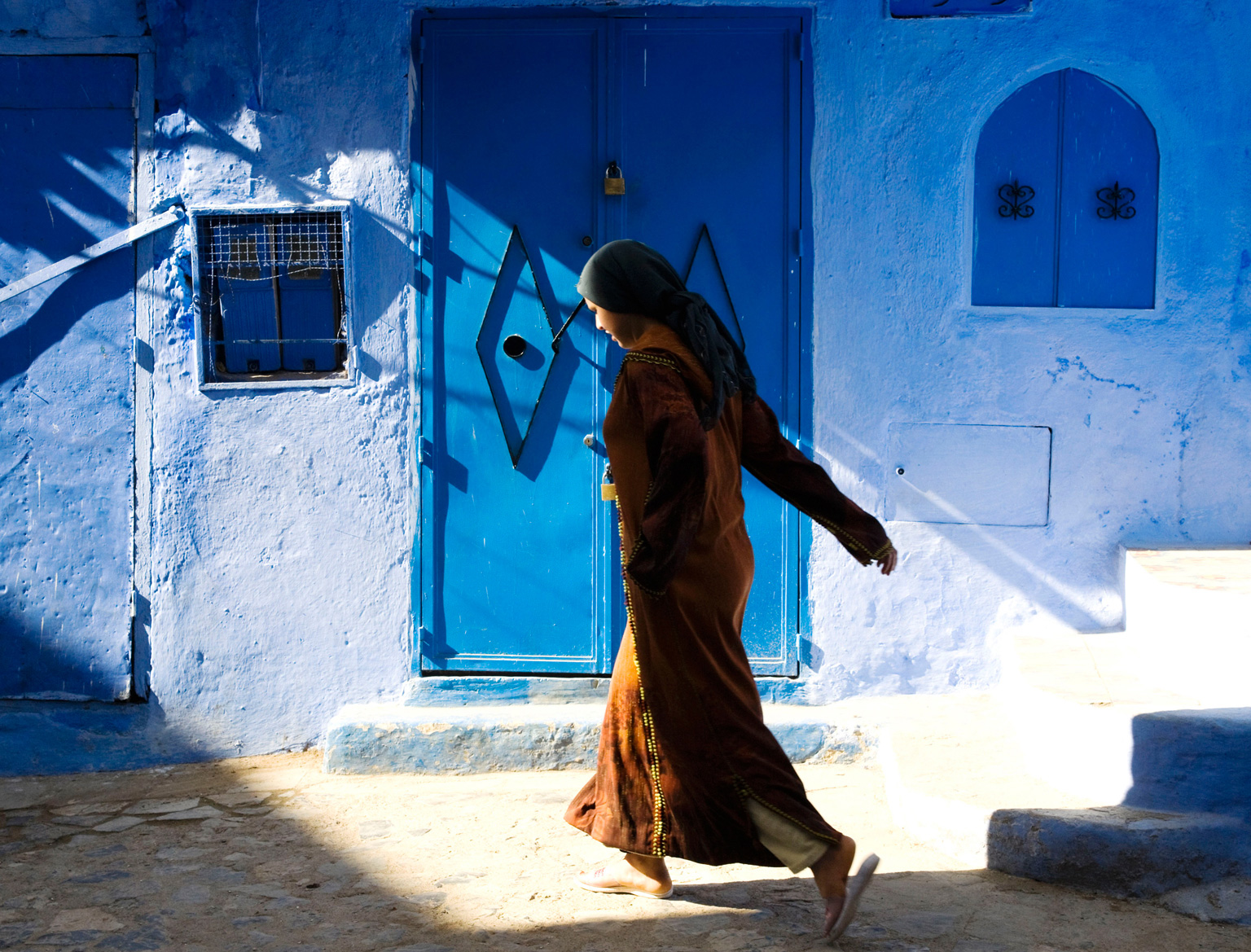
1 Chefchaouen Simply the most beautiful small town in Morocco, its blue-washed walls enclosed by mountains.
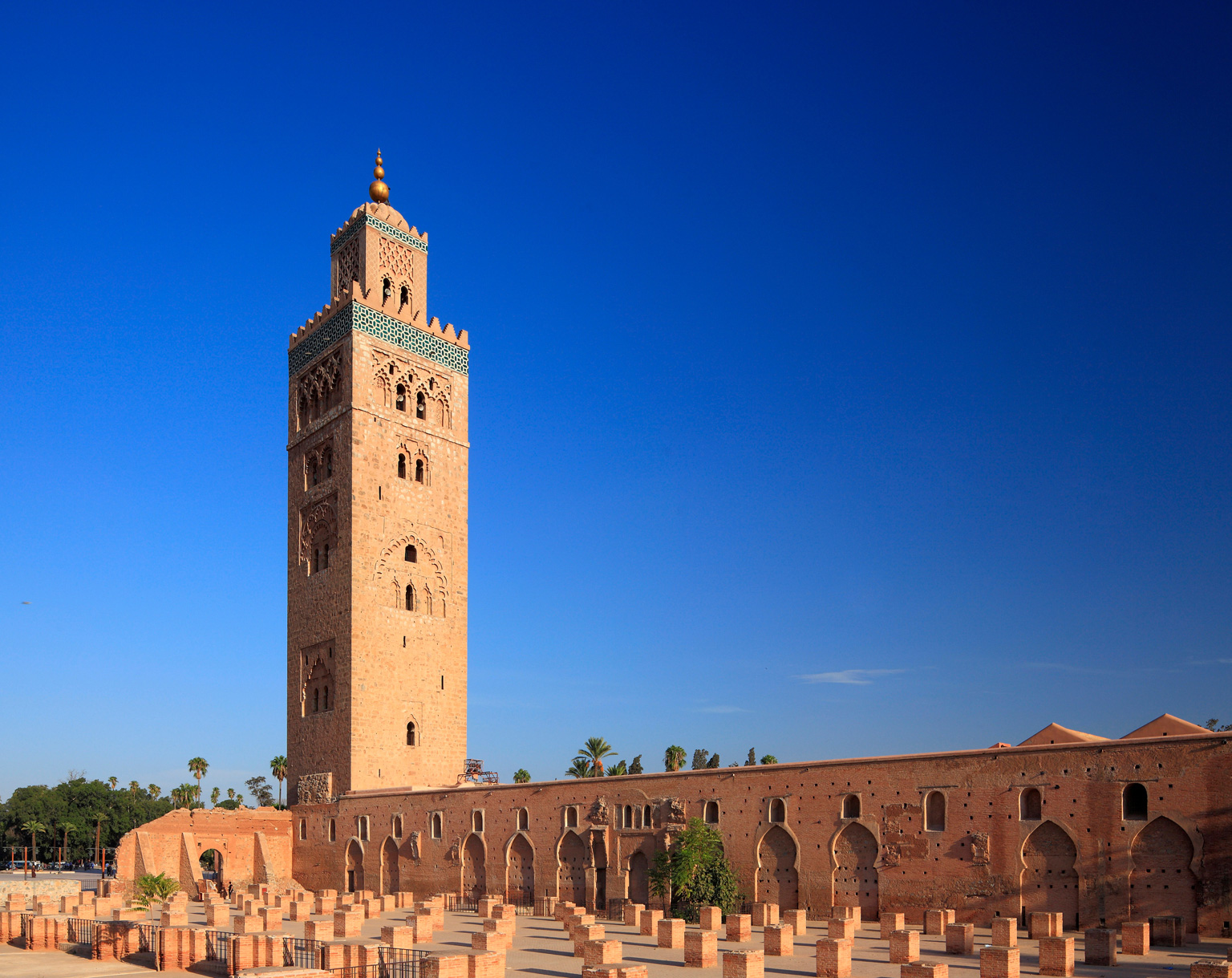
2 Koutoubia Mosque The symbol of Marrakesh, the Koutoubia’s twelfth-century minaret is visible for miles around the city.

3 Camel trekking Venture into the Sahara on an overnight camel trek from Zagora, M’Hamid or Merzouga.
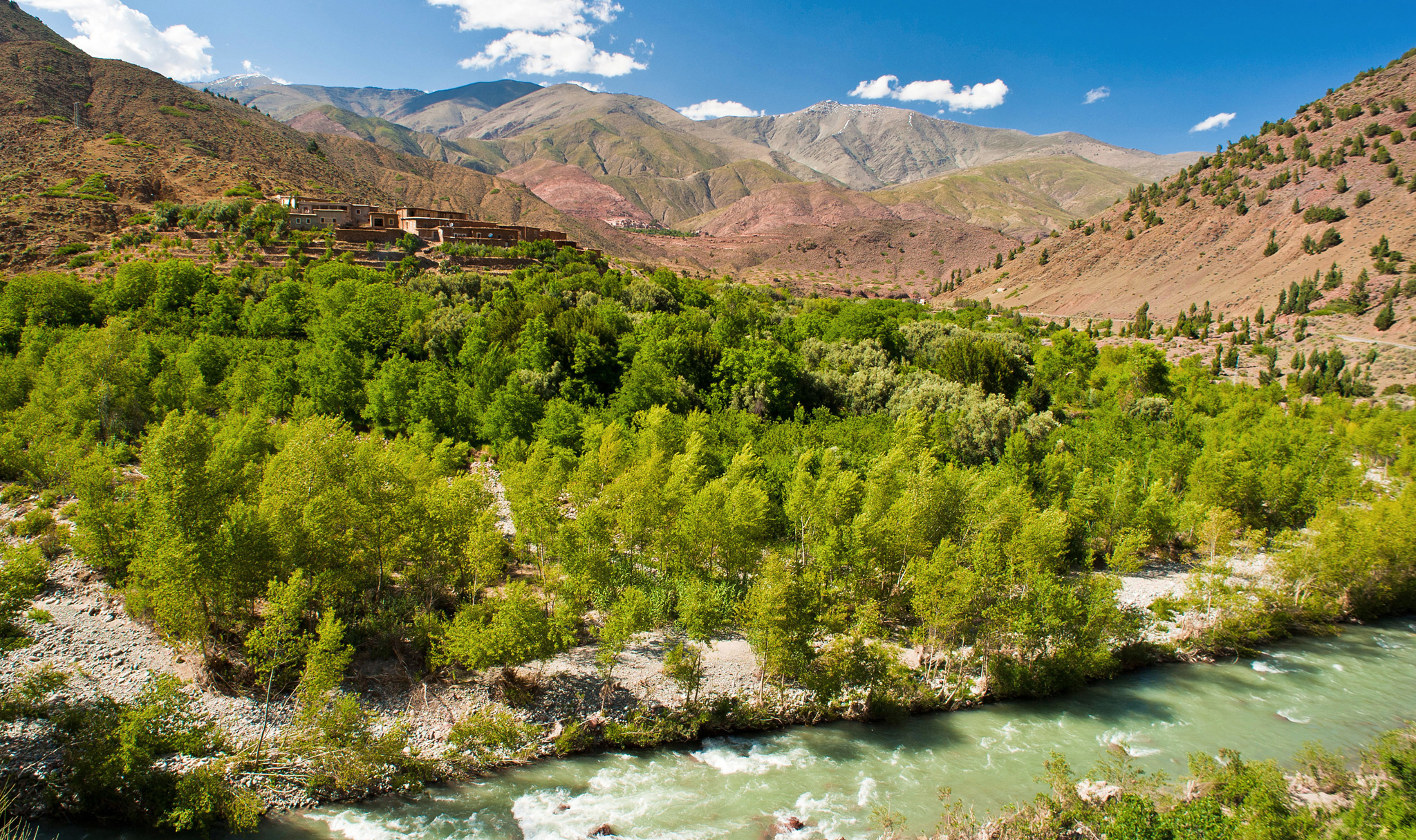
4 Atlas passes The nerve-shredding Tizi n’Test and the higher Tizi n’Tichka wend up over the Atlas mountains, providing breathtaking views along the way.
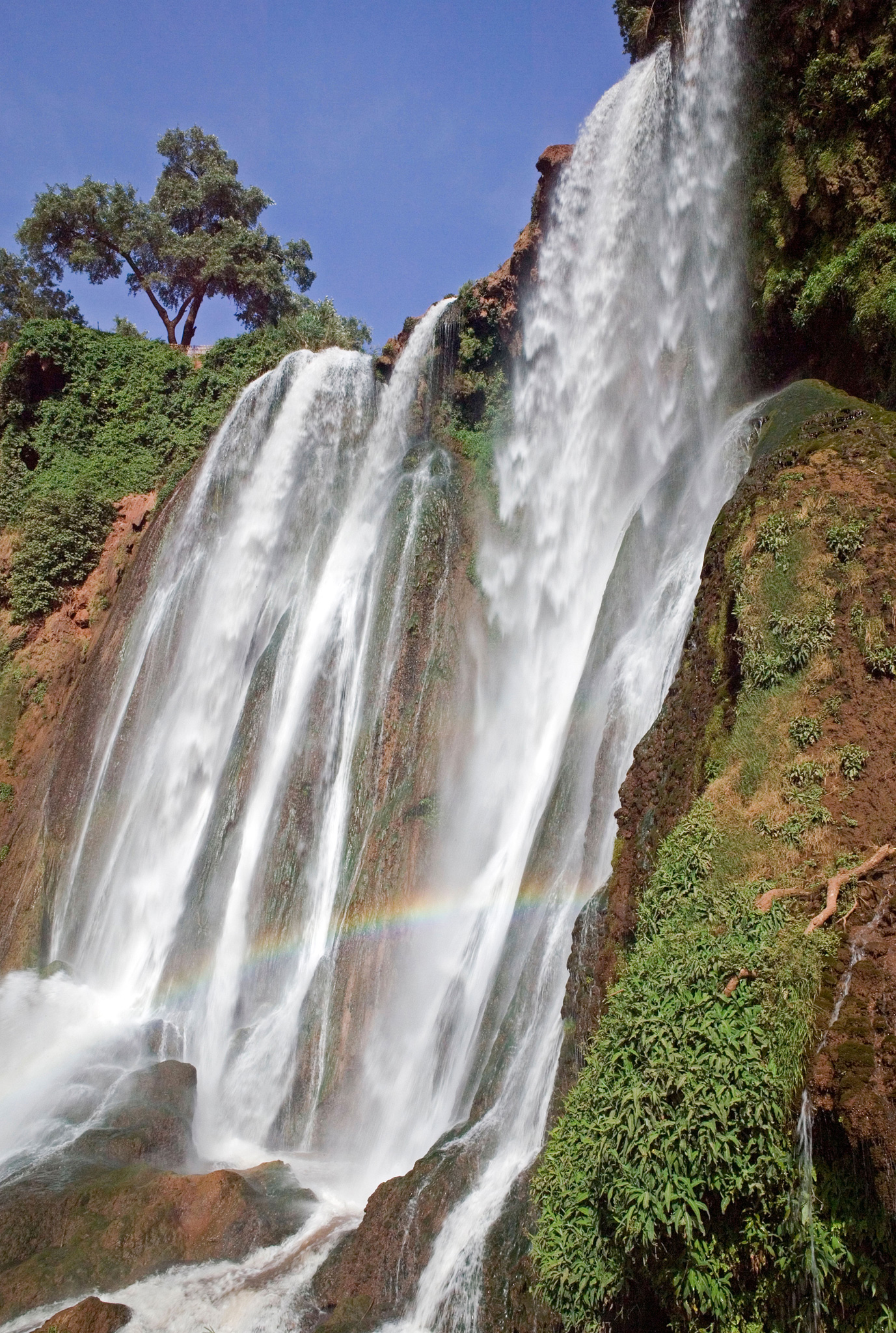
5 Cascades d’Ouzoud The most dramatic of the country’s waterfalls, with overhanging cafés, and inviting pools to plunge into.

6 Fez The most complete medieval city in the Arab world, Fez’s labyrinthine streets conceal ancient souks and iconic monuments, none more so than the exquisitely decorated Medersa Bou Inania.
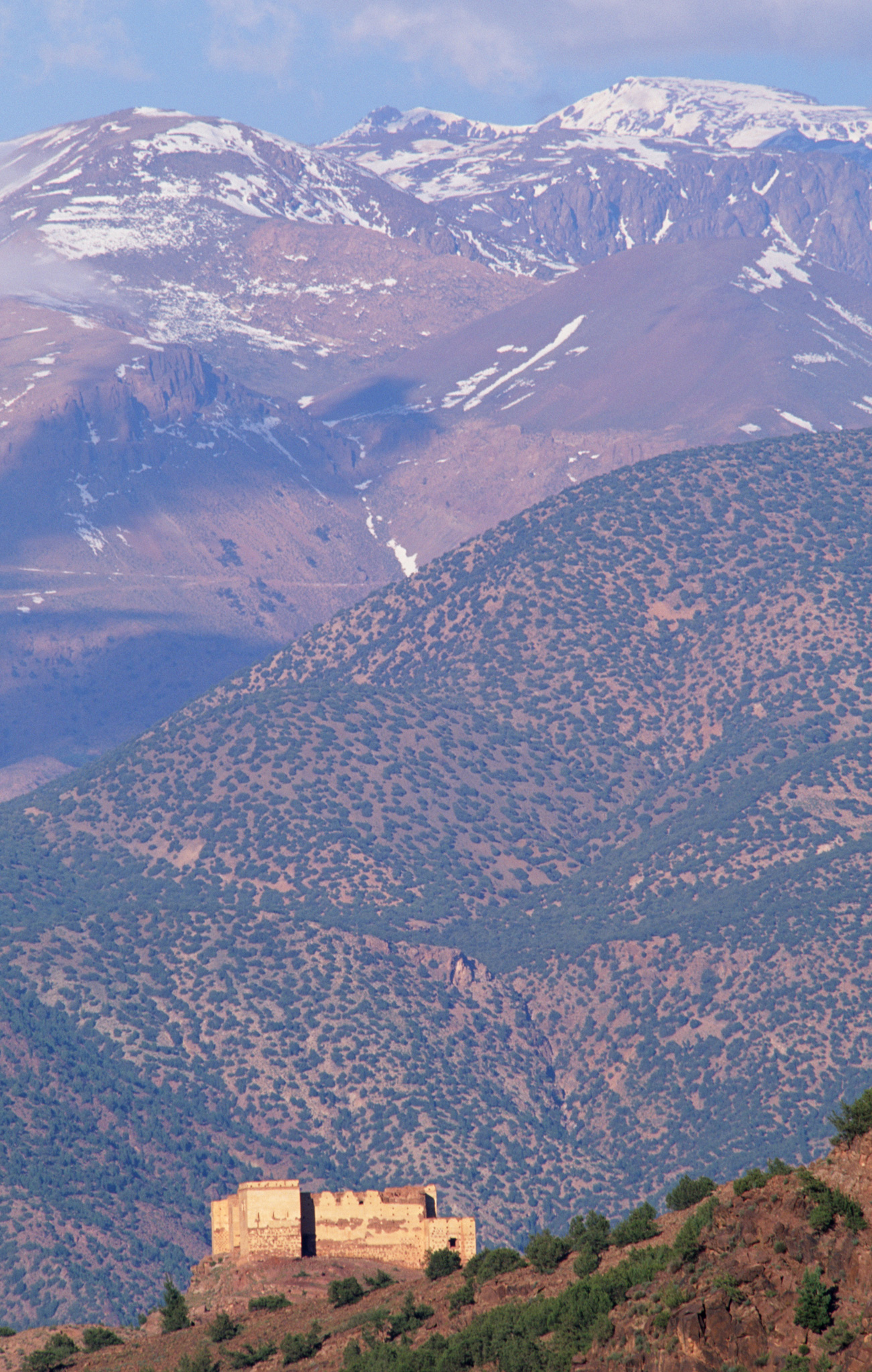
7 Tin Mal Mosque This great Almohad building stands isolated in an Atlas river valley.
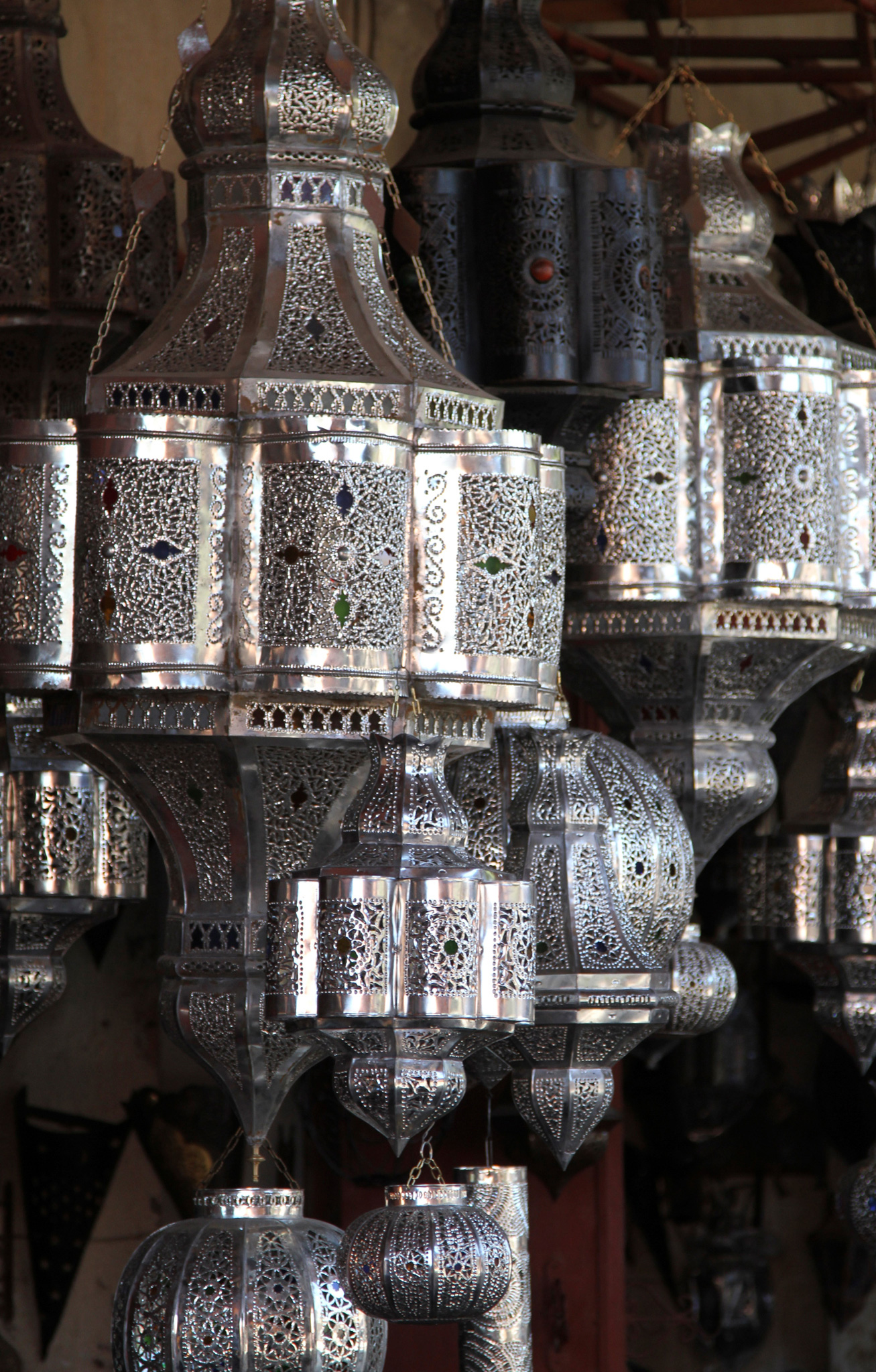
8 Crafts From carpets and carpentry to leatherwork and ceramics, Morocco’s craft tradition is extraordinarily vibrant, and on magnificent show in its souks.
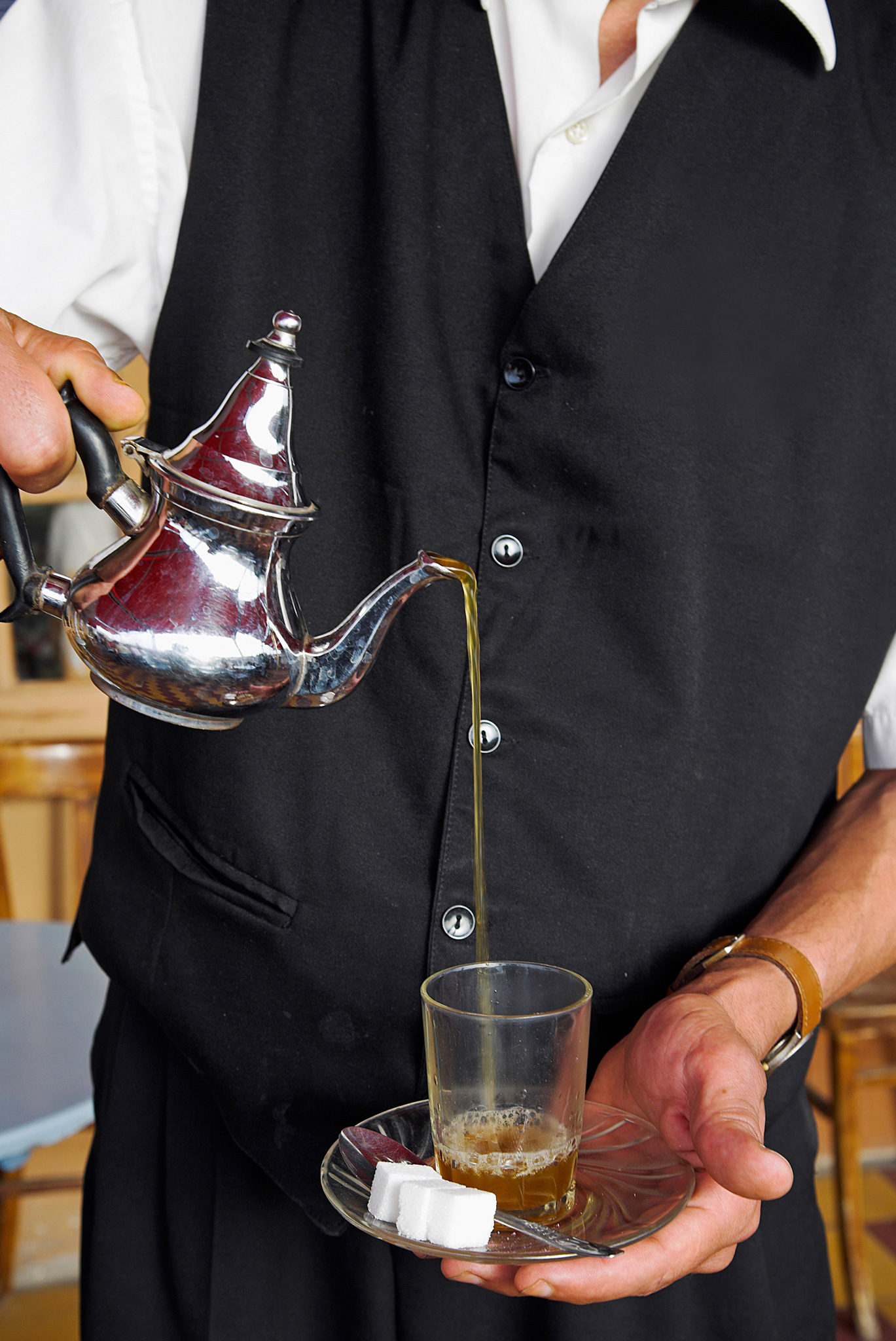
9 Tea “Whisky Marocain” (mint tea) is the accompaniment to any discussion or transaction.

10 Bab Oudaïa, Rabat The most beautiful gate of the medieval Moorish world.
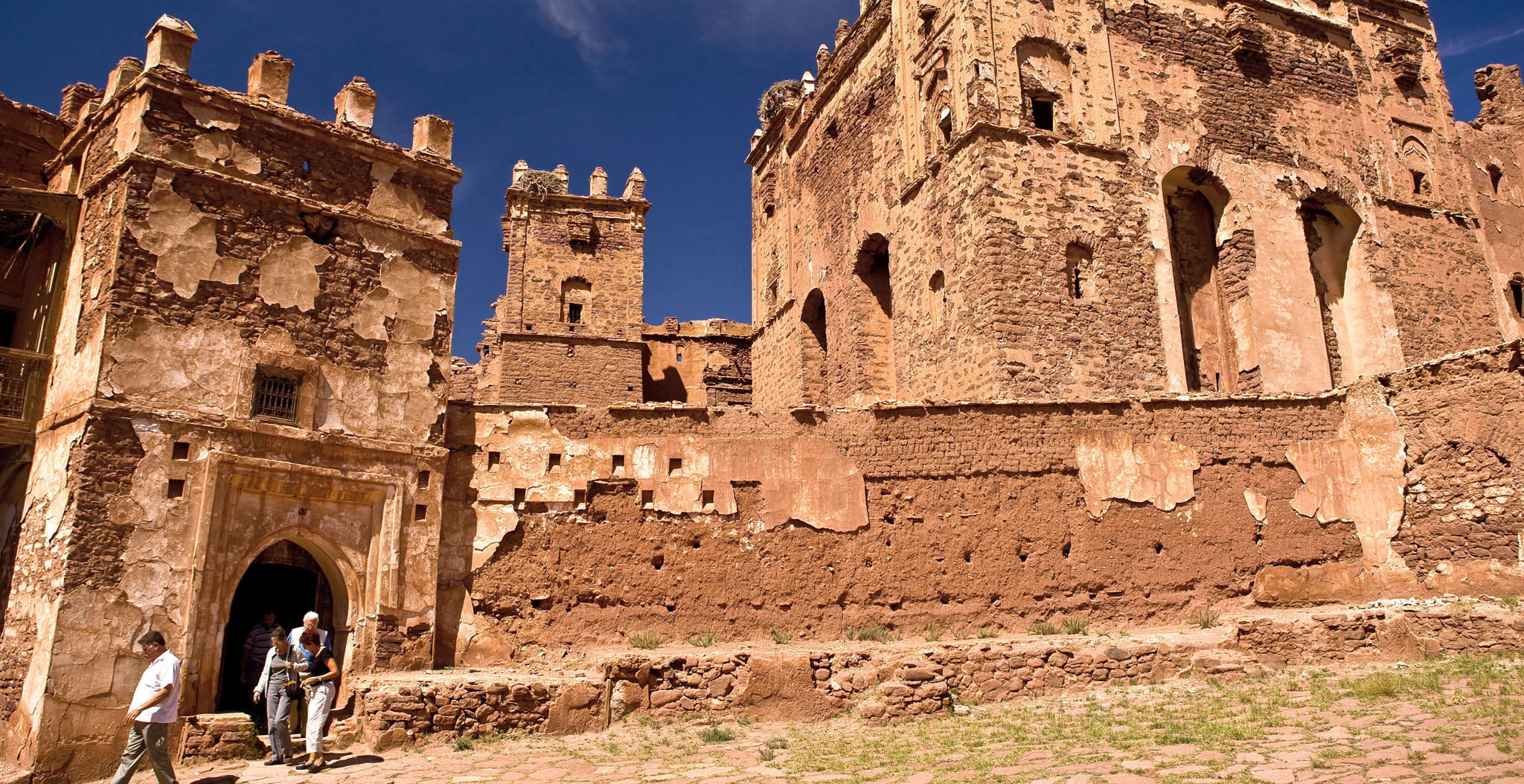
11 Telouet An evocative relic of the time when the infamous Glaoui clan ruled over the Atlas and Marrakesh.
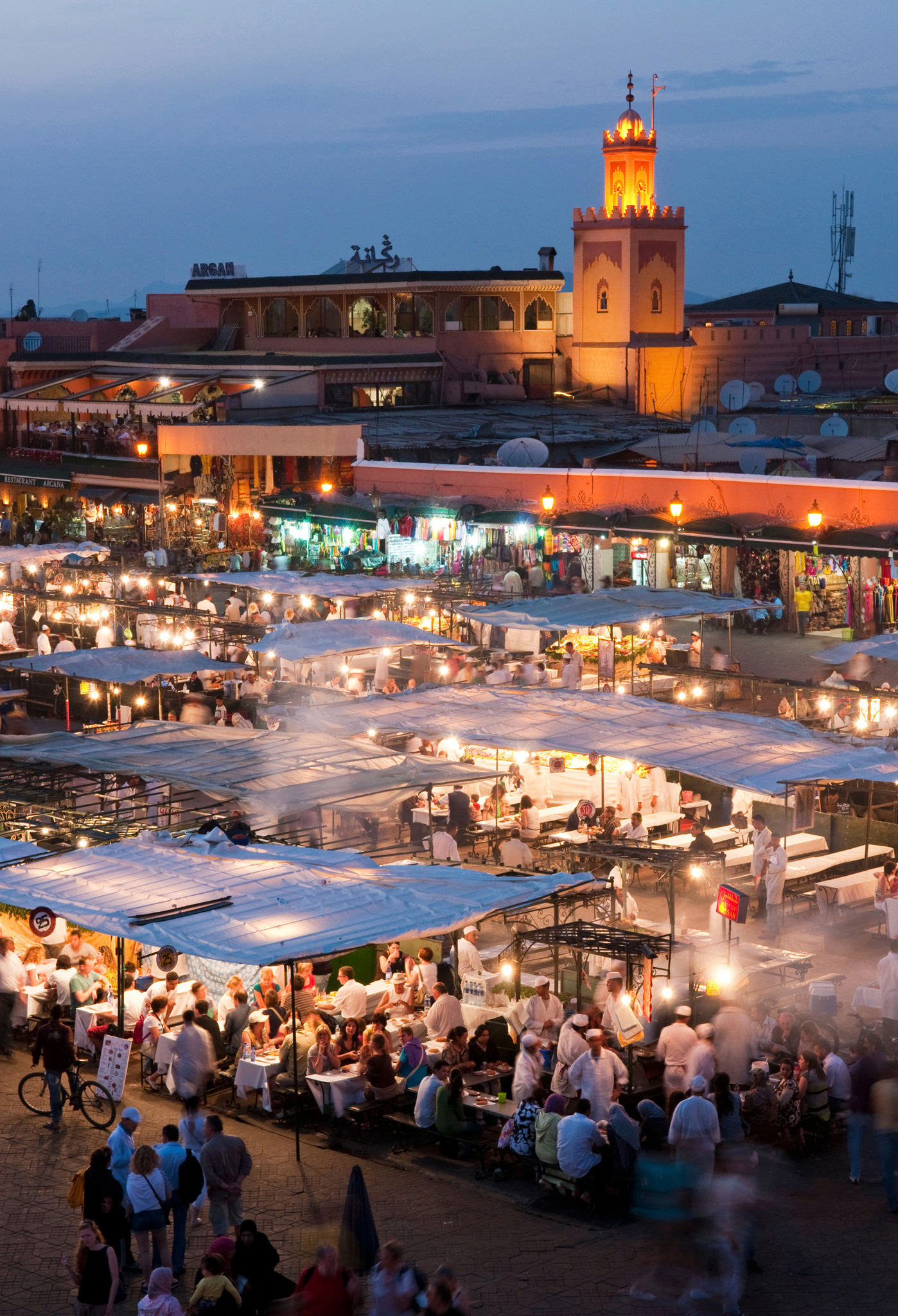
12 Jemaa el Fna, Marrakesh Musicians, acrobats and storytellers converge each night on this spellbinding city square.

13 Todra Gorge Take a walk (or a climb) in the majestic Todra Gorge, with its towering 300m canyon walls.
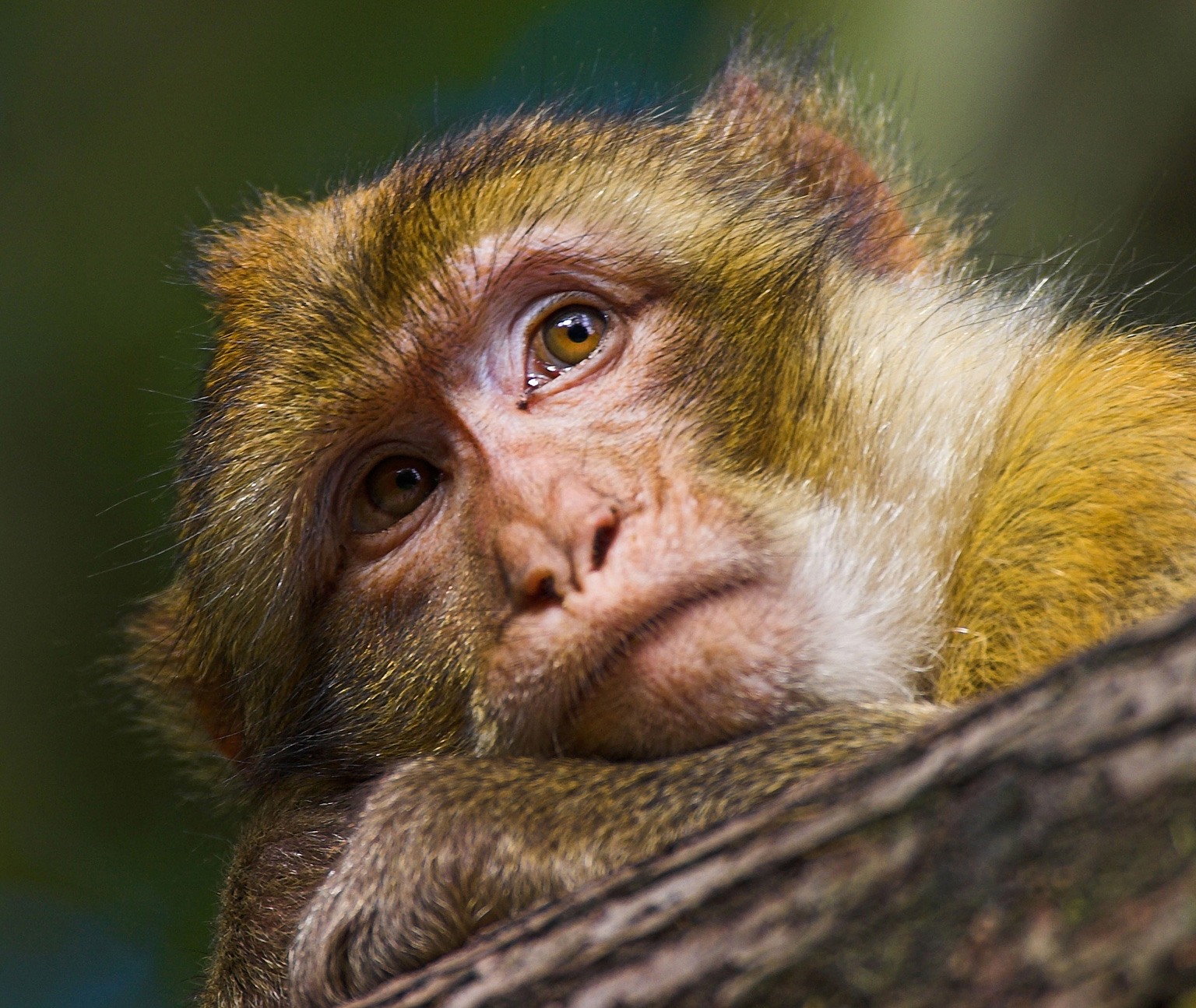
14 Barbary Macaques Troupes of these endangered “apes” inhabit the cedar forests of the Middle Atlas.
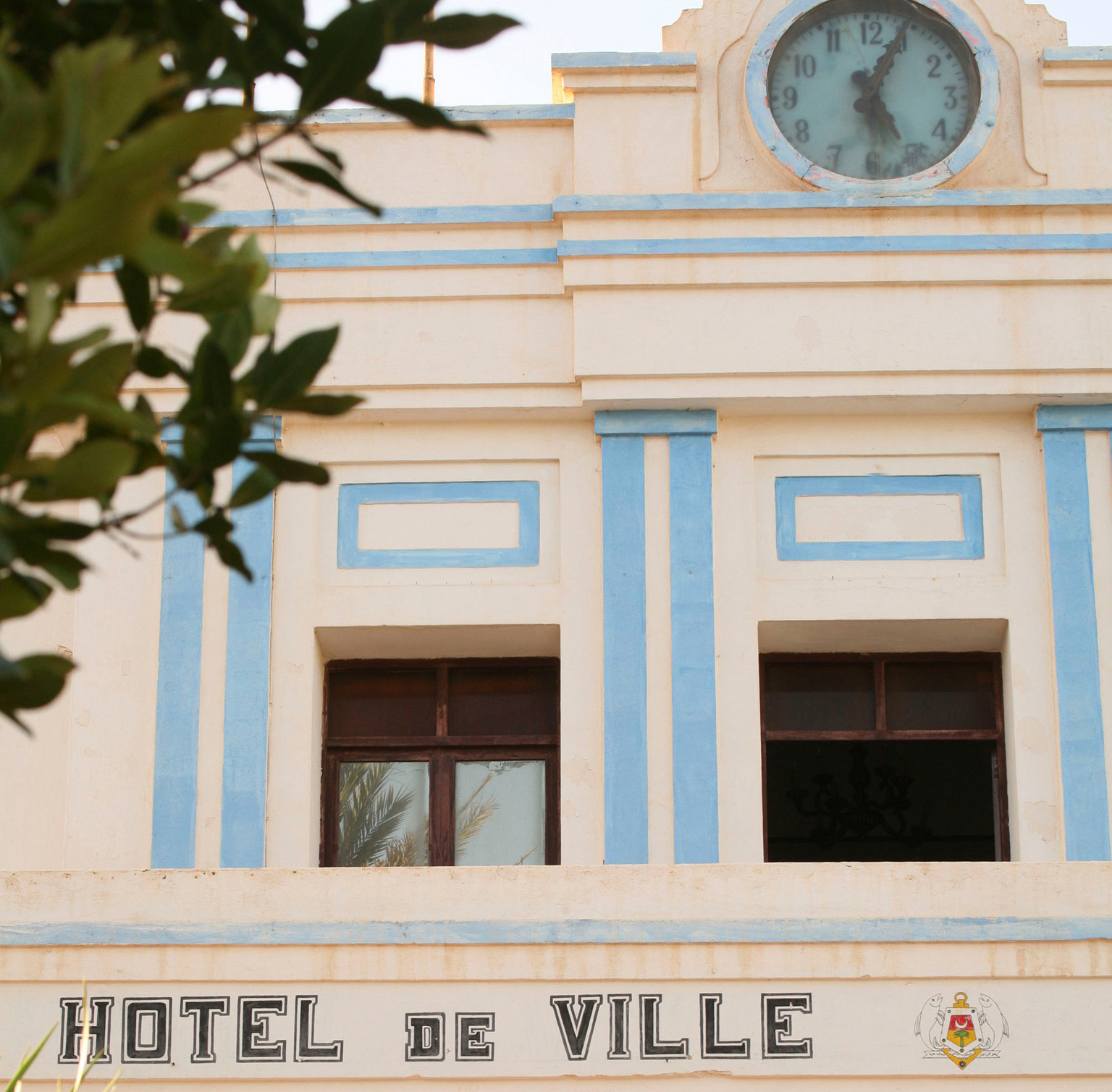
15 Sidi Ifni This old Spanish colonial town retains a seductive array of Art Deco buildings.

16 Casablanca Casa’s colonial architecture blends traditional Moroccan designs with French Art Deco into a distinctive style known as Mauresque.
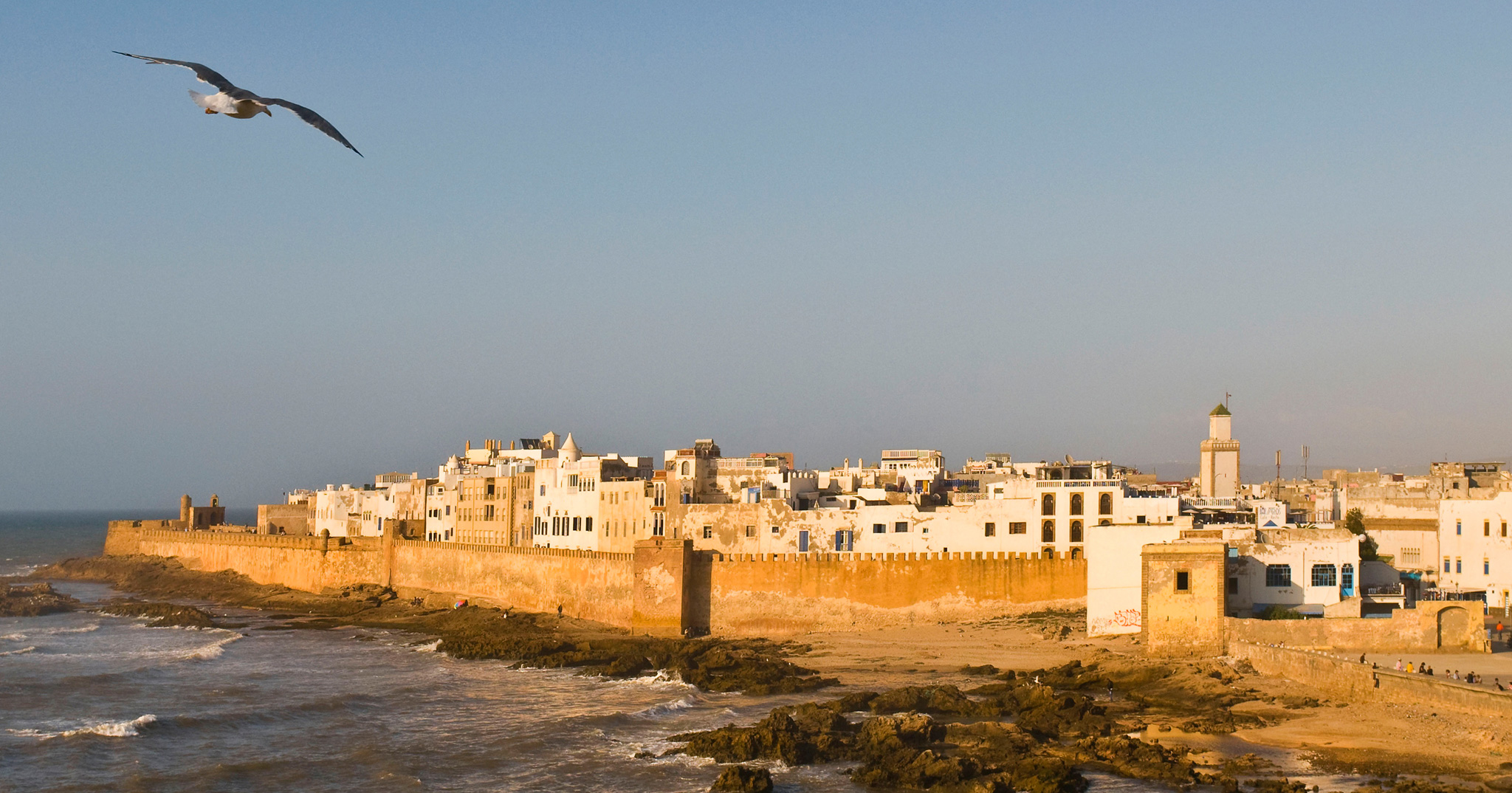
17 Essaouira Relax by the Atlantic at Morocco’s most popular resort, home to a growing windsurfing scene.
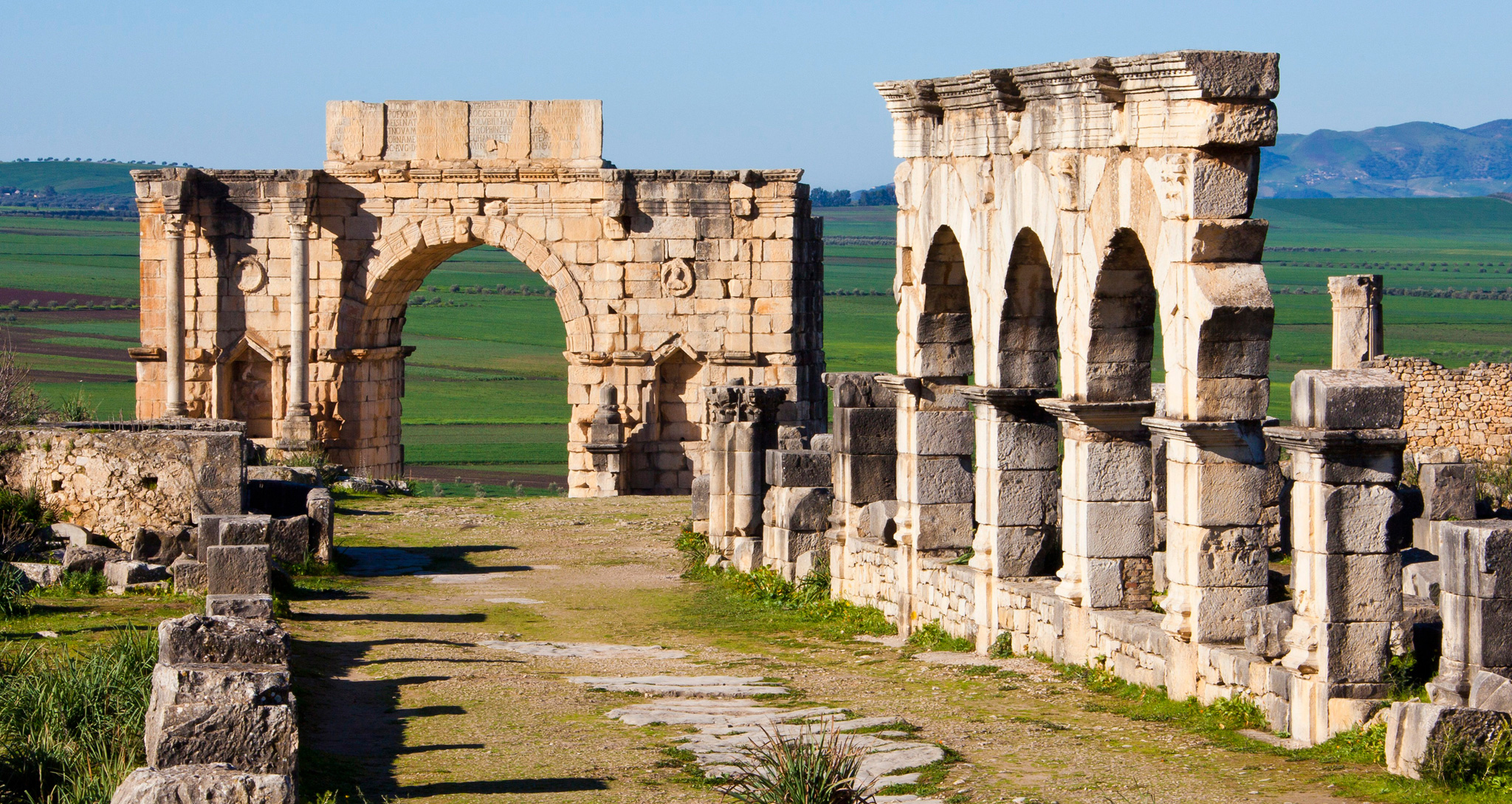
18 Volubilis & Moulay Idriss Visit the remarkable Roman ruins of Volubilis and stay at the holy Islamic town of Moulay Idriss.

19 Tangier The old “International Port”, sometime home of Bowles and Burroughs, has a seedy charm of its own.
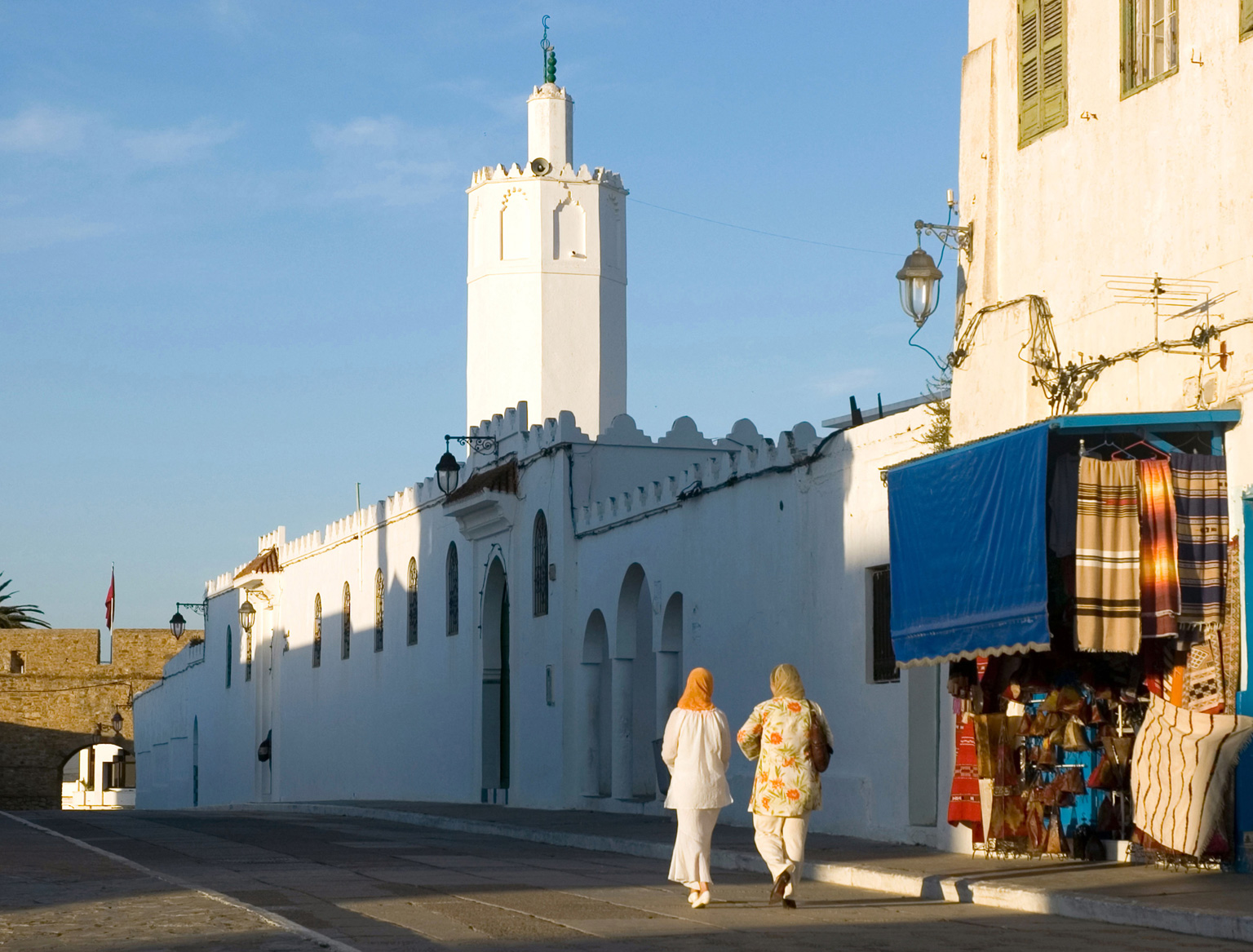
20 Asilah This relaxed seaside town – setting for a first-class cultural festival in August – is home to one of the best beaches on the northwest coast.

21 Skiing at Oukaïmeden Not many skiers can list North Africa – but Ouka is a reliable, low-key resort.
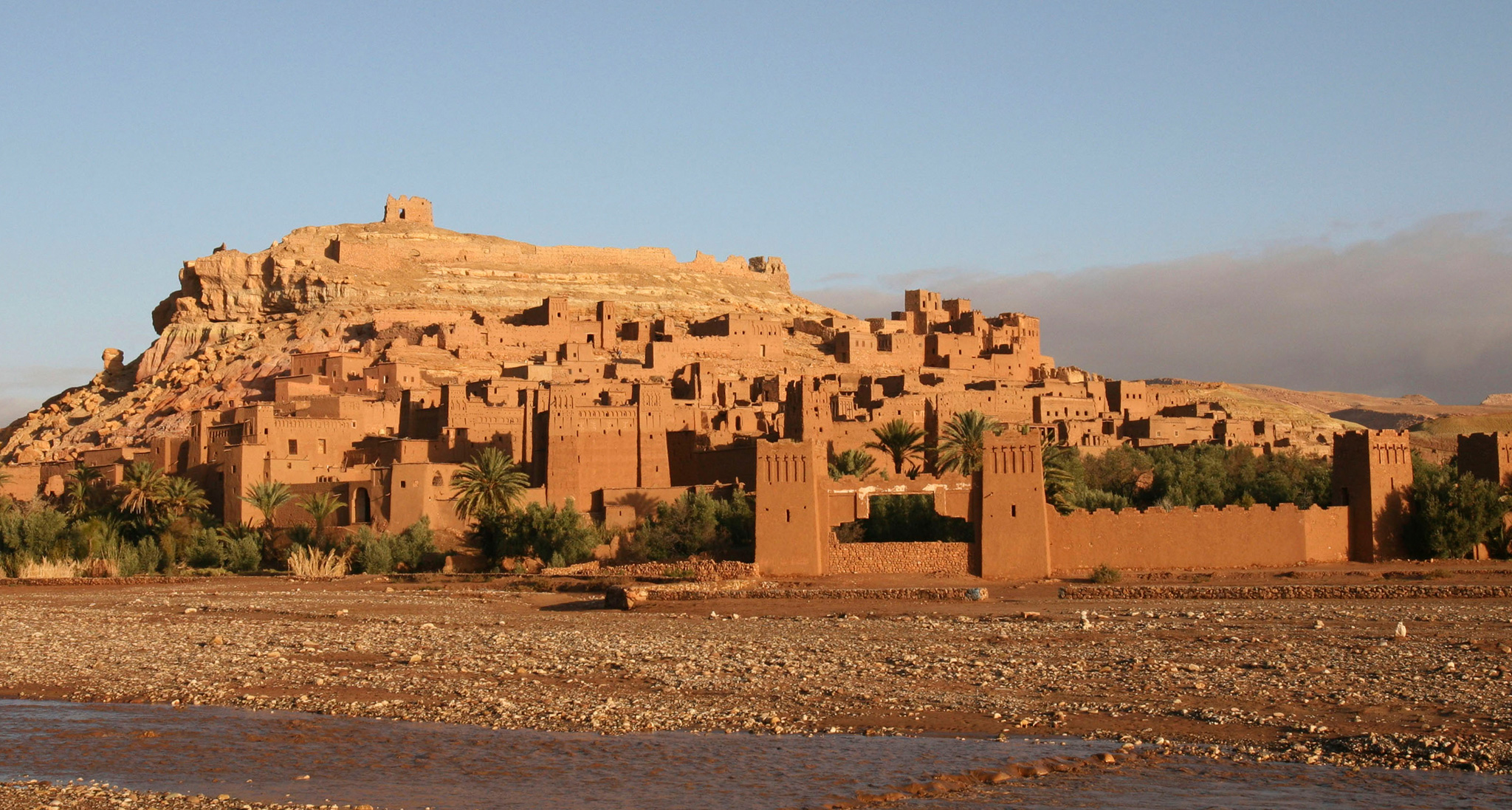
22 Todra Gorge Take a walk (or a climb) in the majestic Todra Gorge, with its towering 300m canyon walls.
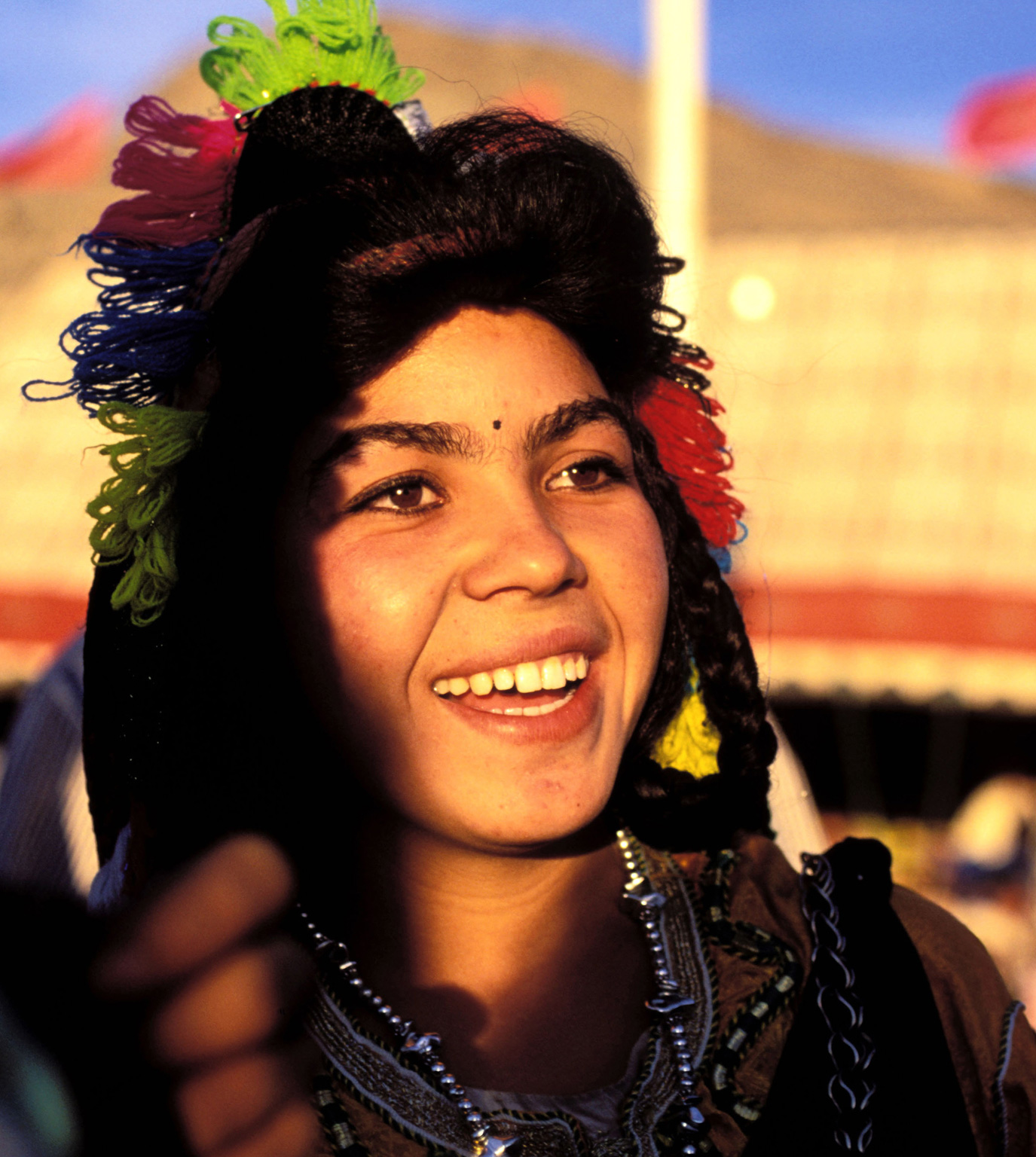
23 Imilchil Moussem The Moroccan cultural calendar is packed with festivals but few can match the largesse of Imilchil’s three-day “Marriage Market”.

24 Birdwatching Morocco offers much to birdwatchers, from storks nesting on minarets to desert bustards, via bee-eaters, flamingos and falcons.
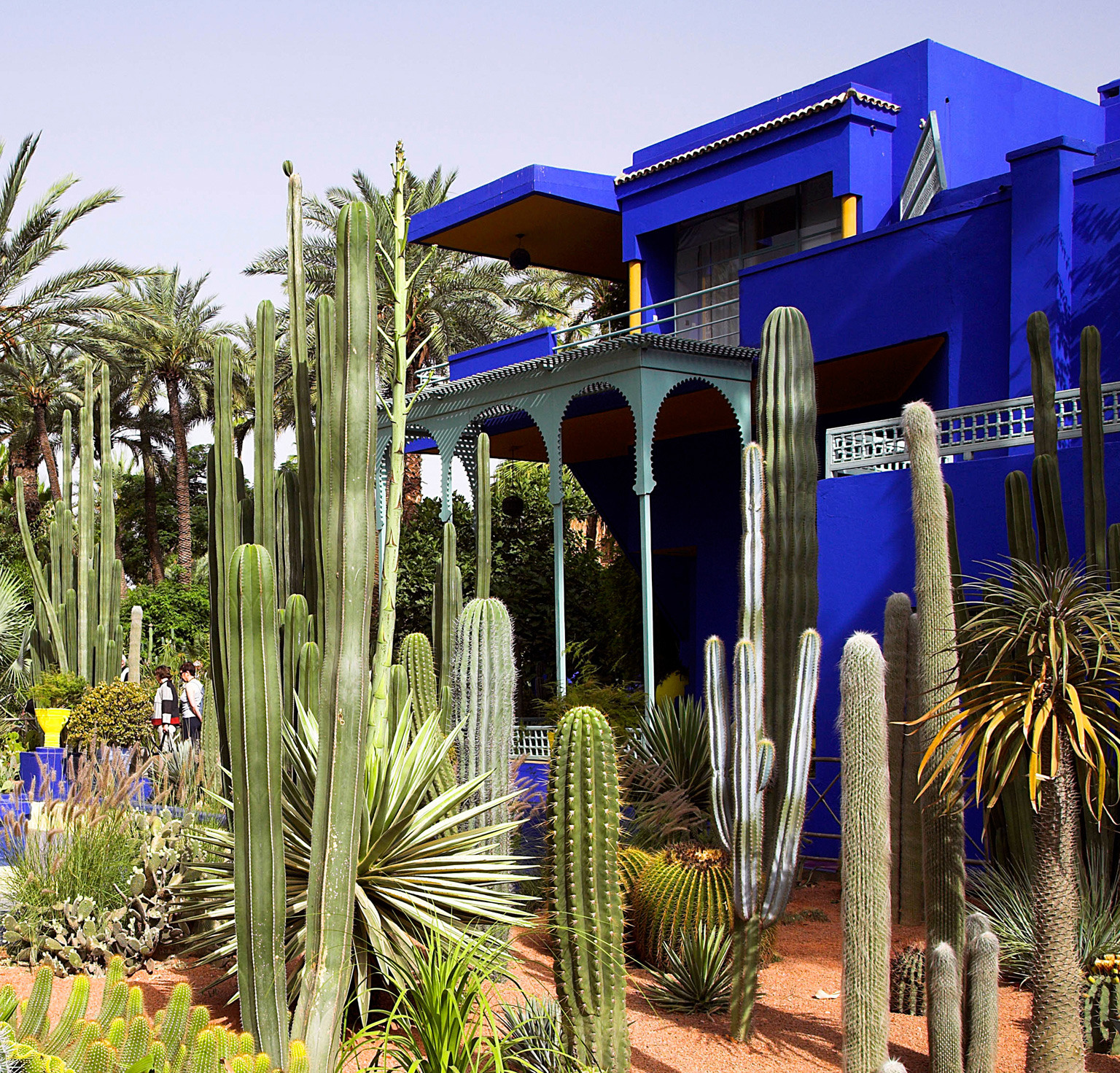
25 Majorelle Garden, Marrakesh A lovely, mature botanical garden, maintained by Yves Saint-Laurent and filled with the sound of birdsong.
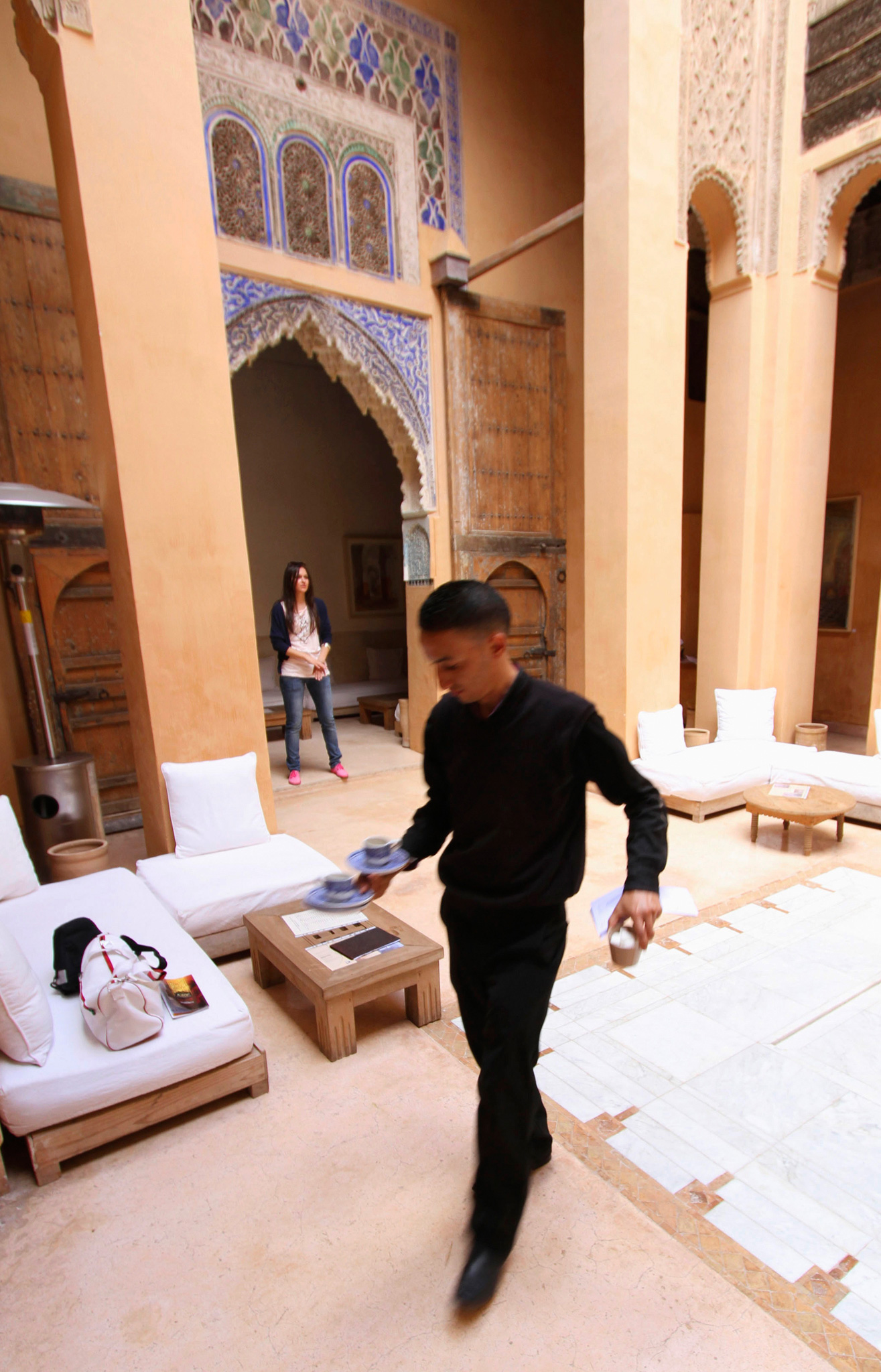
26 Riads These renovated old mansions, centred on a patio and often full of stylish designer touches, provide a tranquil retreat from the outside world.
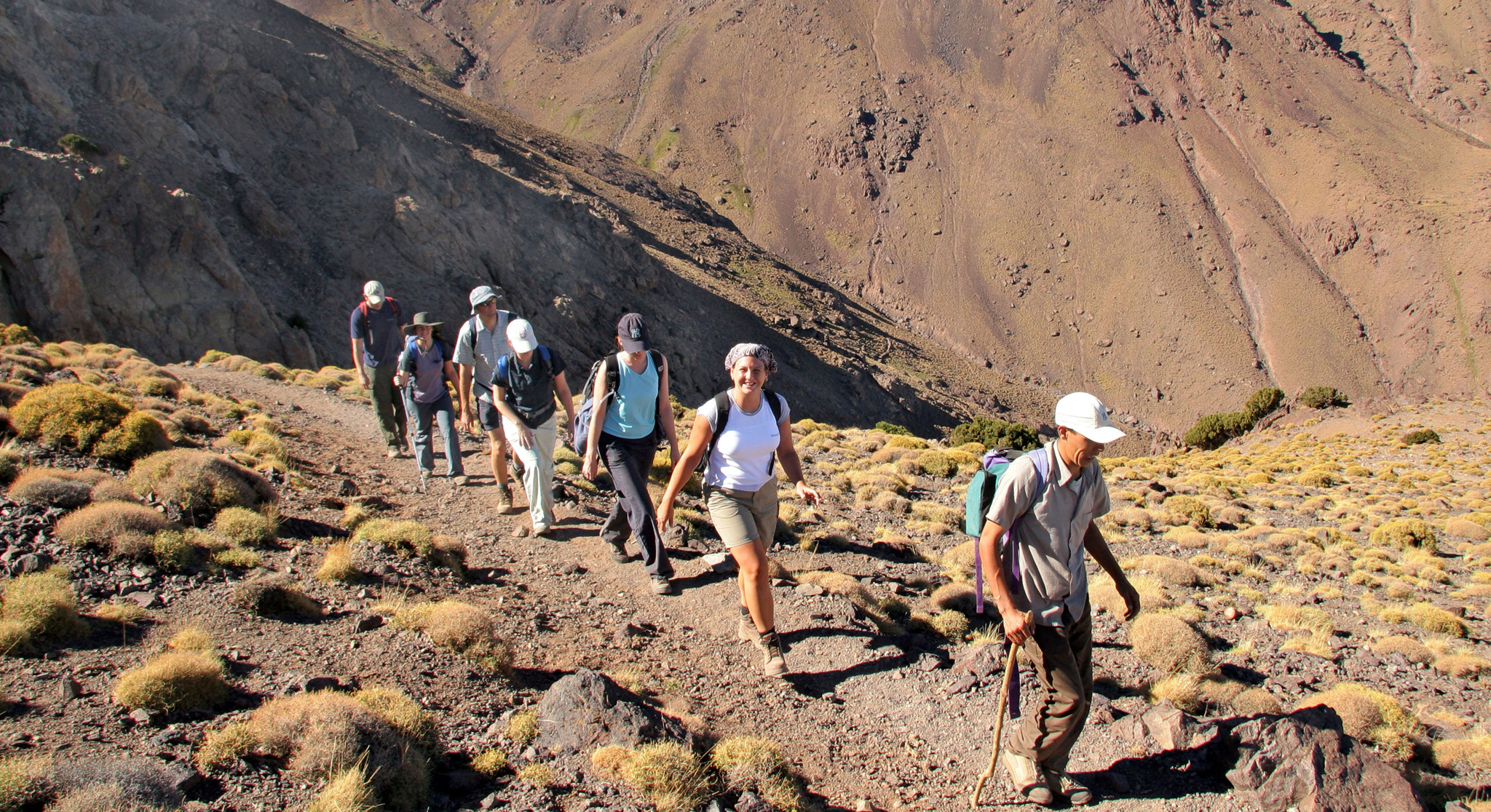
27 Trekking in the Atlas The High Atlas offer fantastic trekking opportunities, from day walks in the Toubkal Massif to expeditions through isolated valleys.

THE ERG CHEBBI DUNES
ITINERARIES
The following itineraries will take you right across Morocco, from the Medinas of Marrakesh and Fez to longer trips into the mountains and the desert beyond. With bustling souks and showpiece squares, crumbling kasbahs and dizzy gorges, there is something for everyone, whether you’re on an exotic weekend city break, stringing together a hit list of the country’s must-see sights, or looking to get away from it all on the back of a camel.
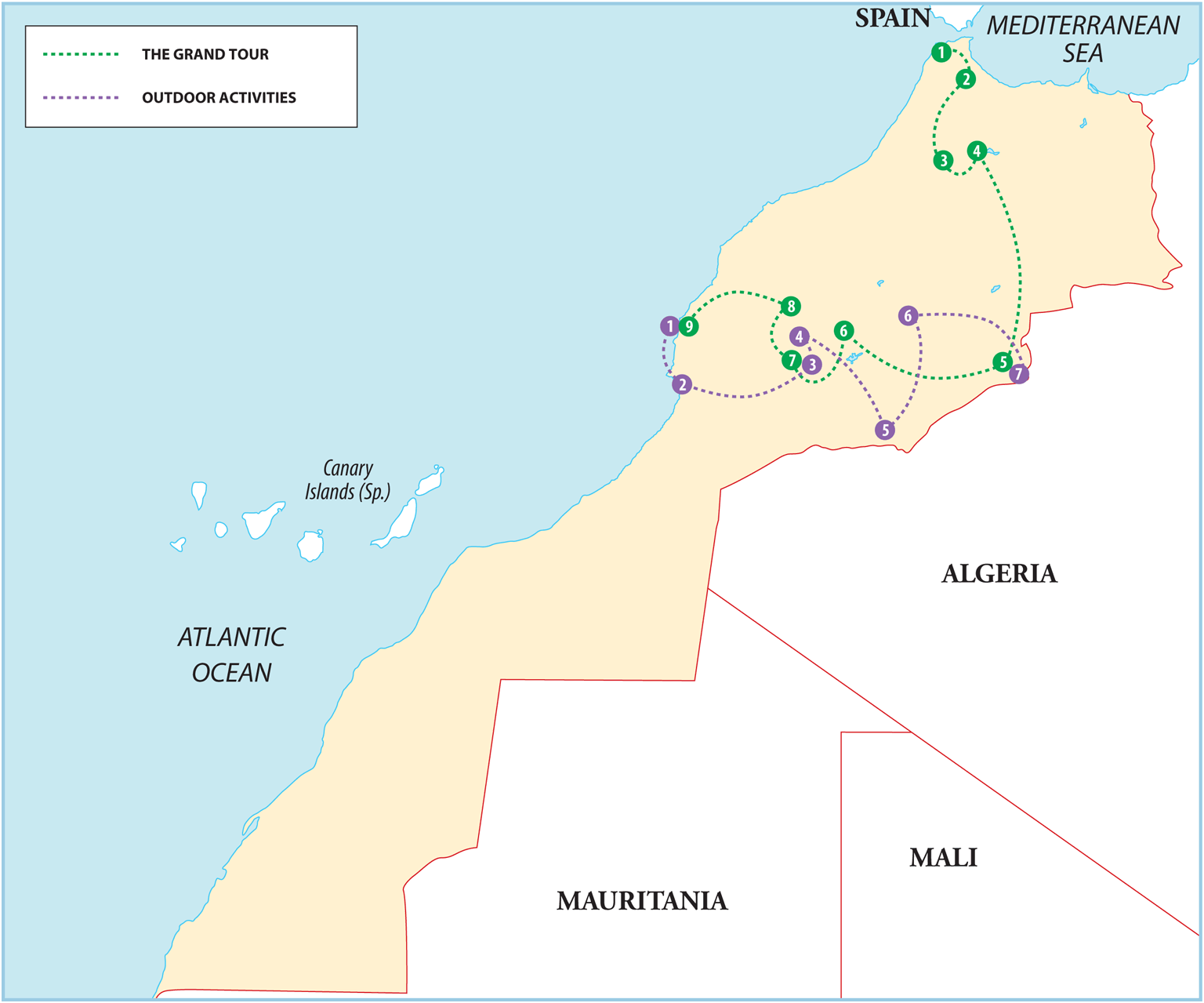
A SHORT BREAK IN MARRAKESH
Day one
Koutoubia Minaret Marvel at the pleasing proportions of this twelfth-century, 70m-high tower.
Jemaa el Fna Head to the city’s famous central square, a feast of visual entertainment.
Dinner Hidden behind clouds of cooking smoke, the Jemaa’s food stalls serve up couscous, fried fish and plenty more besides.
Day two
Ben Youssef Medersa A textbook study in zellij, stucco and carved cedar wood.
Souks Shop for rugs and carpets in La Criée Berbère, or watch the dyers at work in Souk des Teinturiers.
El Badi Palace It may now lay in ruins but this once opulent palace is still a magnificent sight.
Majorelle Garden Head to the Ville Nouvelle for Yves Saint-Laurent’s tranquil gardens.
Dinner Book ahead for fine Marrakshi dining at Le Tobsil, an intimate palace restaurant on a smaller scale than most.
A SHORT BREAK IN FEZ
Day one
Medersa Bou Inania Arguably the finest building in Morocco, and a dazzling testament to the craftsmen of medieval Fez.
Talâa Kebira Journey through the Medina past fondouks and mosques and souks specializing in everything from brass to henna.
Dinner Sample the famous camel burger at hip little Café Clock.
Day two
Nejjarine and Seffarine Take in the sights (and smells) of Place en Nejjarine, the carpenters’ souk, before a spot of people watching on Place Seffarine.
Tanneries A surreal scene: men standing knee-deep in vats of coloured dyes, soaking leather skins red, yellow, blue and black.
Fez el Jedid Home to the synagogues, cemeteries and overhanging houses that make up Morocco’s original Jewish district.
Dinner Eat fine Marrakshi cuisine at Laanibra, in the grand surroundings of a seventeenth-century palace.
THE GRAND TOUR
1 Tangier Take a breather in one of the Petit Socco’s historic cafés.
2 Chefchaouen Laidback and picturesque antidote to Tangier’s bustle.
3 Meknes Wander Moulay Ismail’s monumental Ville Impériale before exploring the Roman ruins at nearby Volubilis.
4 Fez Getting lost somewhere amid the souks and tanneries of Fez el Bali is a quintessential Moroccan experience.
5 Merzouga The Erg Chebbi dunes make a memorable first sight of the Sahara.
6 Aït Benhaddou The exceptional Aït Benhaddou is a kasbah you won’t forget.
7 The High Atlas The best trekking in the country, along ancient mule tracks and through forgotten Berber villages.
8 Marrakesh Barter for babouches and catch the 24hr theatre of the Jemaa el Fna.
9 Essaouira A fish supper is the perfect way to end the day in this artsy coastal town.
OUTDOOR ACTIVITIES
1 Kitesurfing in Essaouira Simply the best place in the country to try your hand at kitesurfing.
2 Surfing near Taghazout Ride Killers, Anchor Point and other challenging breaks at this relaxed surfers’ hangout.
3 Hiking in the High Atlas A wealth of scenic routes cut across the Toubkal Massif.
4 Skiing at Oukaïmeden Hitting the slopes at Oukaïmeden is worth it for the novelty value alone.
5 Camel trekking in the Erg Chigaga M’Hamid is the jumping-off point for camel trips into this remote section of the Sahara.
6 Climbing in the Todra Gorge You could spend days scaling the rocky walls of this dramatic mountain gorge.
7 Sandboarding in the Erg Chebbi A surreal contrast to Oukaïmeden, though carving down the Grand Dune de Merzouga is just as memorable.